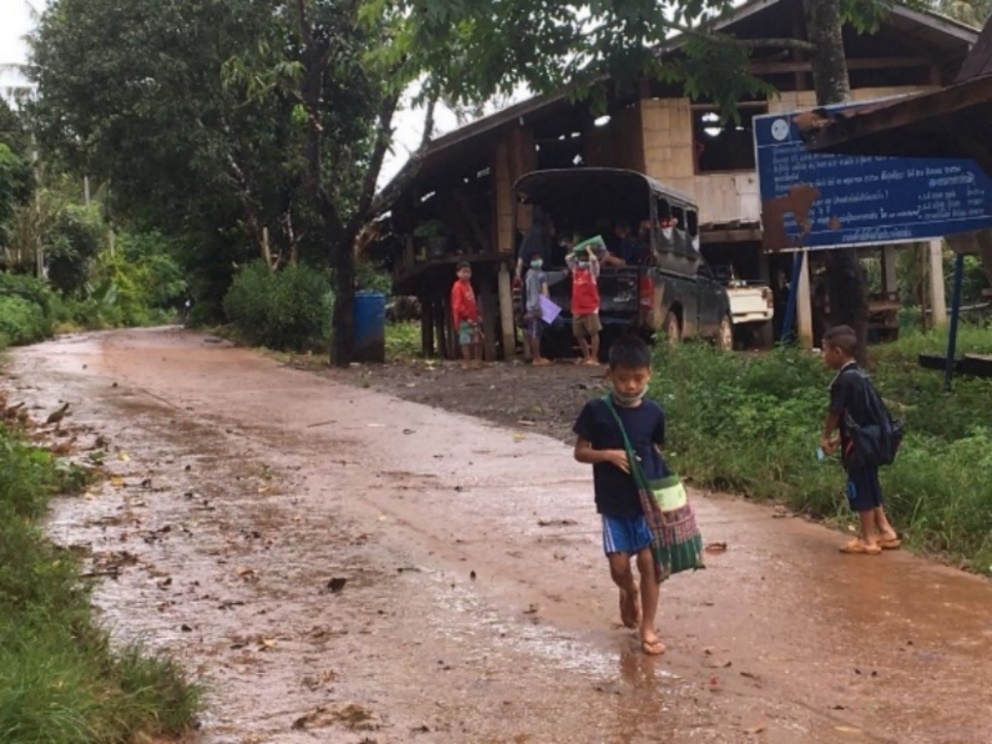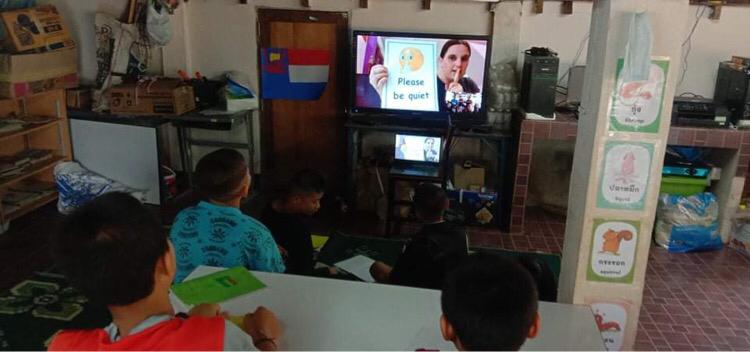KLOTHOR
with Liz O’Sullivan
This year, the Thailand Ministry of Education ordered closure of educational institutions to control the spread during the second wave of the Covid pandemic. The nationwide state of emergency was extended for the 12th time from June 1 to July 31. Almost all educational institutions in the country were closed and more online classes encouraged.
For Liz O’Sullivan, a teacher/ mentor on the Thai/Myanmar border since January 2020, teaching or enabling educational opportunities has changed dramatically. Many students live remotely from the school in Klothor and do not have internet connectivity or devices on which to access remote learning.
In August Liz explained:
“The high schoolers will come to school this week in staggered groups to collect their worksheets. High School students that can will communicate with their teachers via Facebook. Different to Australia where you are not allowed to be Facebook friends with students!
The primary aged students without Wi-Fi or a phone signal where they live must rely on the teachers visiting the villages to explain their work when it is given to them [see feature image]. Each group of teachers was assigned a different village. We were greeted by officials and soldiers as we passed checkpoints and the primary students dutifully waited with masks and social distancing ‘by the book’. Students come in staggered groups over two days so that Covid safe measures are adhered to. No parents holding their hands as they are all mostly at work!”
Some travel a long way to get here and will either walk or ride their motorbike back to their village, trying to keep their worksheets dry if it rains along the way. Many have mountains of paper since they are collecting on behalf of their friends too.

I don’t know if there are many in Australia that can’t communicate with their teachers at all. I can only imagine how parents would react in Australia if students were given a packet of work with no available opportunity for teacher support or feedback?
I do help the students I can through zoom or Facebook video classes. I’m in regular contact with the kids at Xavier House (the dormitory) in Umphang and the online classes are going well. There’s occasional issues with the Wi-Fi but on the whole it’s been ok.

I’m helping some teenagers too from other schools. Some are from my regular Saturday classes in Umphang, some are students from Pattayavit who I’ve taught previously in Umphang, one is from St Josephs, but lives in Mae La Camp. It’s hard to track the learning progress because attendance is inconsistent. But I guess even a little bit of English is better than nothing! Even if they miss the class I try to send them some materials or homework.
I feel a bit like a travelling circus performer, going from class to class and student to student! I’m trying to teach the best I can, but it’s far from perfect.”
NORTH RYDE
by Sam Haddin
Teaching remotely certainly has its challenges.
Teaching in a school that is not in a low socio-economic area, we have had few issues with technology. Most families have multiple devices and our school is a BYOD school, meaning that students from Yr 3 – 6 bring their own device to school ordinarily. So access to technology has not been an issue. There have been a few wifi and slow internet issues with families who have several siblings and parents working from home.
The biggest frustration in terms of the learning is not having full control. I think teachers naturally like being in control and when we have our students in front of us, we are in complete control over their learning. We monitor what they are doing, to what standard they are doing it and can give them immediate feedback as to whether they have done a good job or whether they need to put in more effort.
Of course, with the students learning from home, we don’t have that total control. And it’s frustrating at times because there are students who you know can do better or you know are just doing the bare minimum to say they’ve completed the work and there isn’t really anything you can do about it. We give feedback every day of course, but it’s not as effective as face to face feedback.
Then there’s the worry of the students not fully understanding the concepts being taught, especially those students with learning needs or even those who are just average, middle of the road students who you know would do ok in a classroom because you’re there explaining concepts properly and there are also class discussions where ideas are bounced around. But outside of that classroom environment, they are not reaching their potential. And again, even though we’re available to the students via email, it’s not as effective.
With the students I teach being a little older, I place the responsibility of completing their work to a decent standard solely on them as they are old enough to be independent and the tasks we set are at a level where they shouldn’t need too much assistance. In so doing, we try to not put too much pressure on the parents as many of them are working from home. We communicate with parents every week via a phone call – just to check in. We are also available to parents via email. Parents often vent their frustrations to us – not directed at us (usually) but we seem to be the sounding board for their frustrations with their children and the pressure they feel working from home and trying to support their child. This can be emotionally draining.
The workload has increased dramatically. We are trying to be creative in the lessons we develop so it won’t be boring for the students, while marking over 100 pieces of work a day, answering emails, making phone calls, having zoom lessons and supervising children of essential workers. So we’ve had to think of how we can work smarter, not harder. Two days a week, we don’t mark the students’ work as closely as we usually would – we check that they’ve completed the work and leave one general comment. We discovered an extension where the teacher can leave a voice memo when giving feedback, rather than the teacher typing out comments. This has saved a lot of time and the students like hearing our voices. Also, the students are more likely to listen to feedback than read it. We’ve also had to really think carefully about what we need the students to know and slim down our lessons accordingly. It’s recommended that students complete between 3 – 4 hours a day when learning from home. So we’ve had to be very selective in the content we teach.
Positives – some students have really stepped up and have surprised me with how well they are doing. And they are not the students who I would have expected to do this well with learning from home. They are students who are not particularly higher than other students academically, but have proven to be hard workers and quite creative in the way they present their work.
Some families have sent delicious gifts to the school for the staff to share. It feels good to know that our hard work is appreciated. And I have a better understanding of some of my students, especially those quiet ones who sometimes get overlooked in the bustle of the classroom environment. I have a better understanding of how well they work independently or if they struggle. And because they don’t have other students to help them in the classroom, I have a better understanding of their capabilities.
